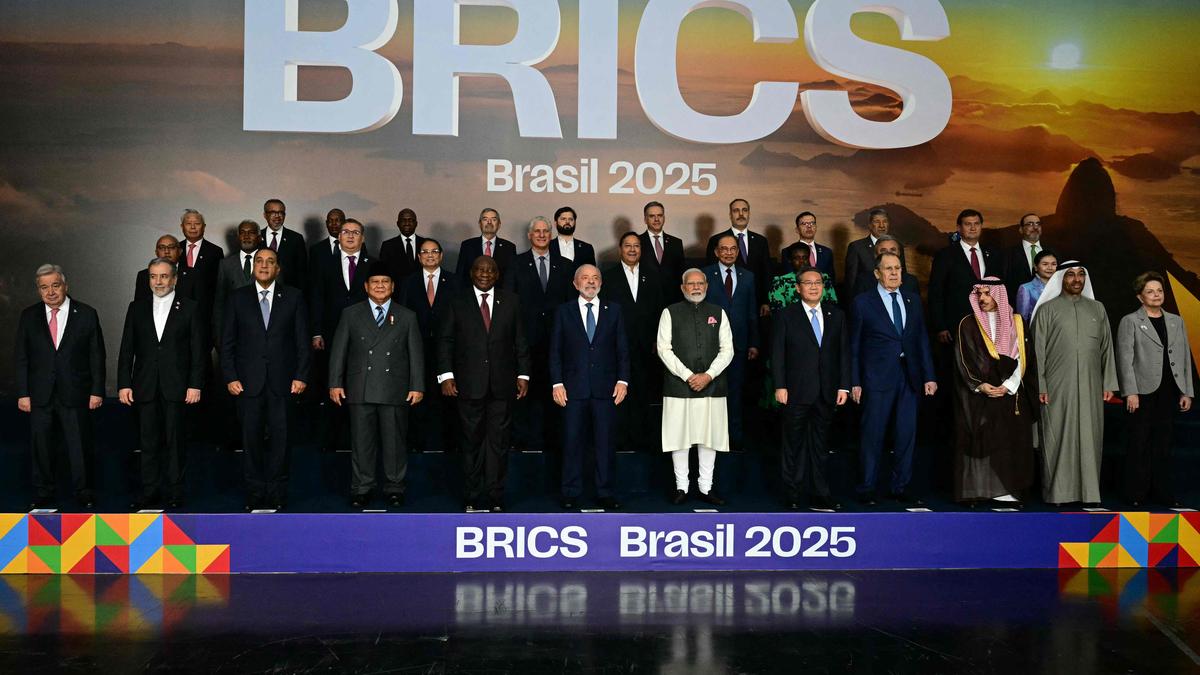U.S. President Donald Trump’s latest announcement to impose a 10% tariff on BRICS nations, alongside a potential 200% levy on pharmaceutical imports, signals a dramatic shift in how the world’s largest economy seeks to wield its influence. For India, which recently submitted a comprehensive trade offer covering goods worth $150-200 billion to the U.S., this rhetoric threatens not only the flow of exports but also the trust underpinning one of its most important economic partnerships. As global trade teeters on the edge of uncertainty, Mr. Trump’s strategy to “weaponise” tariffs is poised to reshape not only bilateral deals but also the foundational dynamics of multilateral blocs, such as BRICS.
BRICS blowback
President Trump’s decision to target the BRICS bloc with a blanket 10% tariff is more than a fiscal policy — it is a symbolic strike against a coalition perceived to be challenging U.S. hegemony. BRICS, comprising Brazil, Russia, India, China, South Africa, and newer entrants such as Iran, Egypt, and the UAE, has gained traction as a geopolitical alternative to Western-dominated platforms. The bloc’s collective economic weight, accounting for nearly 32% of the global GDP and over 40% of the global population, has given it newfound assertiveness, including moves to settle trade in local currencies and reduce dependence on the U.S. dollar.
The U.S. administration, viewing this as a threat, opted for aggressive tariff-based retaliation. According to the Office of the United States Trade Representative (USTR), total U.S. imports from the BRICS nations amounted to $886 billion in 2024, with China and India being the largest contributors. A 10% tariff on this volume would potentially generate over $88 billion in additional duties, effectively acting as a deterrent to BRICS expansion and dollar decoupling. India, as both a BRICS member and a strategic U.S. partner, finds itself in a delicate position — caught between bloc solidarity and bilateral dependence.
Targeting India’s export backbone
Mr. Trump’s rhetoric around a “very, very high rate” of 200% tariff on pharmaceuticals directly strikes at the heart of India’s export economy. India is the largest provider of generic drugs globally, with the U.S. being its most significant customer of these drugs. In the financial year 2024-25, India exported pharmaceuticals worth $9.8 billion to the U.S., a 21% increase from the previous year’s, accounting for more than 30% of all Indian drug exports. The Indian pharmaceutical sector is not just a business; it is a lifeline for the American healthcare system, supplying affordable generics, vaccines, and essential medicines.
A 200% tariff, if implemented, would drastically raise the price of Indian drugs in the U.S. market, disrupting supply chains and possibly triggering domestic drug shortages. Moreover, the impact would not be restricted to Indian exporters. American consumers, especially Medicare and Medicaid beneficiaries, may bear the brunt of price hikes. In States such as Texas, California, and Florida, which are major recipients of Indian pharma shipments, this move could have a ripple effect on the political landscape as healthcare costs soar. Whether this is a negotiating tactic or a serious policy shift is unclear, but the implications are severe.
On the industrial front, India’s $2 billion copper export sector, with the U.S. accounting for $360 million or 17%, is another casualty of this tariff-driven agenda. Copper, a critical component in technology and infrastructure, saw India regain export momentum after the reopening of capacities shut during the pandemic. A 50% tariff on copper will erode the competitiveness of Indian producers, particularly those in Gujarat and Tamil Nadu, and shift demand to alternative sources, such as Chile or Peru.
Between alignment and autonomy
Trump’s tariff threats, cloaked in the language of “economic nationalism”, mark a decisive shift from collaborative trade engagement to unilateral economic coercion by the U.S. For India, which has been walking a tightrope between its strategic autonomy within BRICS and its growing partnership with Washington, this development presents a critical diplomatic inflection point. New Delhi’s recently tabled trade proposal, valued at $150-200 billion, now teeters in uncertainty as the White House weighs domestic populism against long-term global cooperation.
India has made it clear that no further concessions are on the table, signalling a firm stance amid rising pressure. However, this stand-off reveals a deeper global reality: in today’s geopolitical climate, trade is no longer merely transactional — it is a contest of power, alignment, and sovereignty. Should the U.S. proceed with its punitive tariff agenda, it may secure momentary tactical gains but at the cost of alienating key partners such as India, which is increasingly exploring alternative multipolar alliances.
For BRICS, this aggressive turn by Washington could serve as a unifying catalyst, accelerating internal cohesion and driving a shift away from U.S.-centric trade frameworks. Ironically, by attempting to fracture the bloc’s influence through tariffs, Trump may have strengthened its resolve and relevance. In weaponising trade, the U.S. risks not only isolating itself but also fuelling the very multipolar world order it seeks to resist.
Vipin Benny is Assistant Professor and Research Supervisor, St. Thomas College (Autonomous), Thrissur, Kerala, and the author of ‘Elevating Excellence: The Relevance of Internal Marketing in Higher Education Institutions in India’ (2023) and ‘Decoded Decisions: Behavioural Finance Meets Artificial Intelligence’ (2025). Views are personal
Published – July 15, 2025 12:20 am IST
